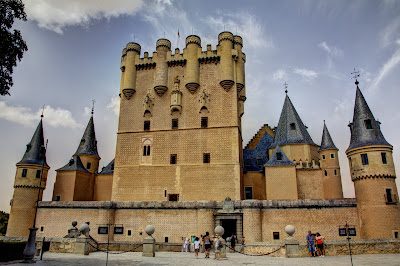The Roman Aqueduct of Segovia was built at the end of the 1st century or early 2nd century. It is the most important work of Roman engineerin
After taking pictures of the Aqueduct, we stopped at a little restaurant that served thick hot chocolate and churros, a popular Spanish treat:
We are still wondering how the stones in the aqueduct remain together with not one bit of mortar:
The Aqueduct of Segovia and the Plaza de Azoguejo (on the other side of the aqueduct) in Segovia, Castilla y León, Spain:
The Catedral de Segovia:
A view of the old city wall and city of Segovia from the Plaza de la Reina Victoria Eugenia near the Alcázar.
The Alcázar de Segovia is shown below. Alcázar is an Arab word meaning castle. From Wiki: Rising out on a rocky crag above the confluence of the rivers Eresma and Clamores near the Guadarrama mountains, it is one of the most distinctiv
Ramparts of the Moorish castle, Alcázar of Segovia:
Another view of the old city wall and cathedral tower of Segovia.
The ancient San Miguel Church of Segovia:
After visiting Segovia, we traveled by bus to the city of La Granja, where we enjoyed a visit to the gardens at the Royal Palace of La Granja de San Ildefonso:
The magnificen
Fuente "Los baños de Diana," La Granja, Spain. The fountains were turned off while we were there (and the castle was closed because it was Monday) but we enjoyed the fountain sculptures and the gardens, patterned after the more famous Chateau Versailles, France:
Gardens and fountains at La Granja:
Fuente "el Canastillo
One last view of the magnificent Acueducto de Segovia before we headed back to Madrid:
It's no wonder that Segovia is a UNESCO World Heritage Site and one of the most visited cities in Spain. For more pictures, click here.


















Absolutely beautiful pictures! What a wonderful place!
ReplyDeleteStunning! Is it the places or the photographer that make it seem like I'm there in person? It must be both.
ReplyDeleteI love it! I am an LDS too and learned through my ancestry records that my ancestors came from north of spain. Sigh! could they been Segovianos too? would love to visit the city and the church!
ReplyDelete